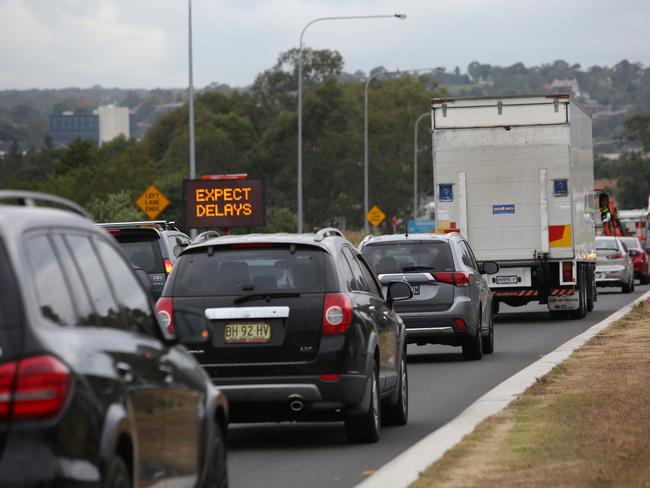Mark Latham: Immigration is destroying housing affordability, we need an Australia-first migration program
IMMIGRATION is pumping up Australia’s economy while destroying housing affordability and wages growth, says Mark Latham.

Opinion
Don't miss out on the headlines from Opinion. Followed categories will be added to My News.
IN the great debate about housing affordability, a new mantra has emerged on both sides of politics. It’s yet another three-word slogan: “improved urban planning”.
Instead of cutting immigration numbers to bring down housing demand and housing prices, Liberal and Labor are focusing on just one side of the housing market: increased supply.
They want to flood the Sydney basin with wall-to-wall urbanisation.
They are building a vast metropolis, extending to Appin in the southwest and abutting the Blue Mountains in the west.
Most of the growth is concentrated in a new residential corridor between Penrith and Camden — building a city the size of Canberra along the spine of the narrow, two-lane Northern Rd.
This is the snake oil of our time: the fantastic notion that in a city already heavily congested, we can swamp Western Sydney with new arrivals and new suburbs and somehow the magic of “improved urban planning” will produce a metropolitan nirvana.
The head of the Greater Sydney Commission, Lucy Turnbull, has said “we need to plan for an additional 1.74 million people by 2036”, mostly in Sydney’s West.

She’s part of the cheer squad for “improved urban planning”, with “an aspiration for a 30-minute city”, so everyone can live within half-an-hour of his or her workplace.
Tell her she’s dreaming.
The only way Sydney can become a 30-minute city is if the Turnbulls buy everybody a helicopter.
Out my way, we have heard it all before. I grew up at Green Valley, where better planning was supposed to deliver a model garden estate.
Instead, it dumped thousands of low-income families into a place without jobs, services or public transport.
It was so rough The Sun newspaper labelled us “Dodge City”.
In 1995 I moved to Campbelltown, which had been overrun by population growth in the preceding decades. The result was a series of dormitory suburbs from which commuters travelled long distances each day — for much of the year, leaving and coming home in the dark.
Around this time, the NSW government’s urban planners decided to rely on a single access road between Campbelltown and Camden, two of the fastest growing districts in the state.
It was called Narellan Rd, stretching seven kilometres from Campbelltown TAFE to the Harrington Park housing estate.
In 2007 I moved to the southern side of Camden, knowing that future development on the northern stretch — through Elderslie, Harrington Grove, Oran Park and Leppington — would be a nightmare, with non-stop road works and disruption.
Today, this area is our answer to Shanghai, with bulldozers, construction zones and new suburbs springing out of the ground like molehills.
Narellan Rd has become a carpark.

The 90,000 residents of Camden are expected to travel east, accessing the M5 motorway at Campbelltown, on this one arterial road.
New housing developments are funnelling extra vehicles onto Narellan Rd, as the state government vainly tries to retrofit the construction of extra lanes.
The widening works are laughable, moving at glacial pace.
Southwest Sydney has the worst of all worlds: Shanghai’s residential expansion with Botswana’s road building capacity.

With so much growth on its urban fringe, Sydney’s traffic congestion has turned upside down.
Around the city centre, on roads like the Cross-City Tunnel, you can put down a picnic blanket and enjoy morning tea without too many cars bothering you.
Sixty kilometres away, on Narellan Rd, the morning peak starts at 5.30, with delays stretching to 40
minutes.
Barely a day goes by when we don’t curse this wretched roadway and the imbeciles who planned it.
In 2015, at nearby Leppington, the NSW government opened a new railway station, with thousands of commuter parking spaces.
It looked great at the time but two years later, it’s impossible to find a parking spot after 8am.
The surrounding population growth has been so rapid a multi-store carpark is now needed.
Excuse me, but whenever I hear those words “improved urban planning” I reach for the chuck bucket.
It’s a fraud on our community, and has been for 50 years.
Bob Carr was right.
Sydney is house full.
It will never be a liveable city as long as massive immigration numbers overwhelm our suburbs and clog up our roads.
Why don’t our political leaders understand this reality?
They don’t see the problems because they don’t live near them.
The Big Australia mentality that sustains the nation’s 200,000-plus annual immigration program is the ultimate act of selfishness.
The business lobbyists, economists and MPs pushing for big migration numbers do so safe in the knowledge that overcrowding and congestion will never affect the gentrified, inner-city boroughs in which they live.
They use immigration as a giant Ponzi scheme: artificially pumping up economic growth at a cost to urban efficiency, housing affordability and wages growth.
We need an Australia-first migration program, designed for the benefit of the people who live here, not those wanting to come here.
For Western Sydney, this means abandoning Big Australia and limiting population growth into the region.


